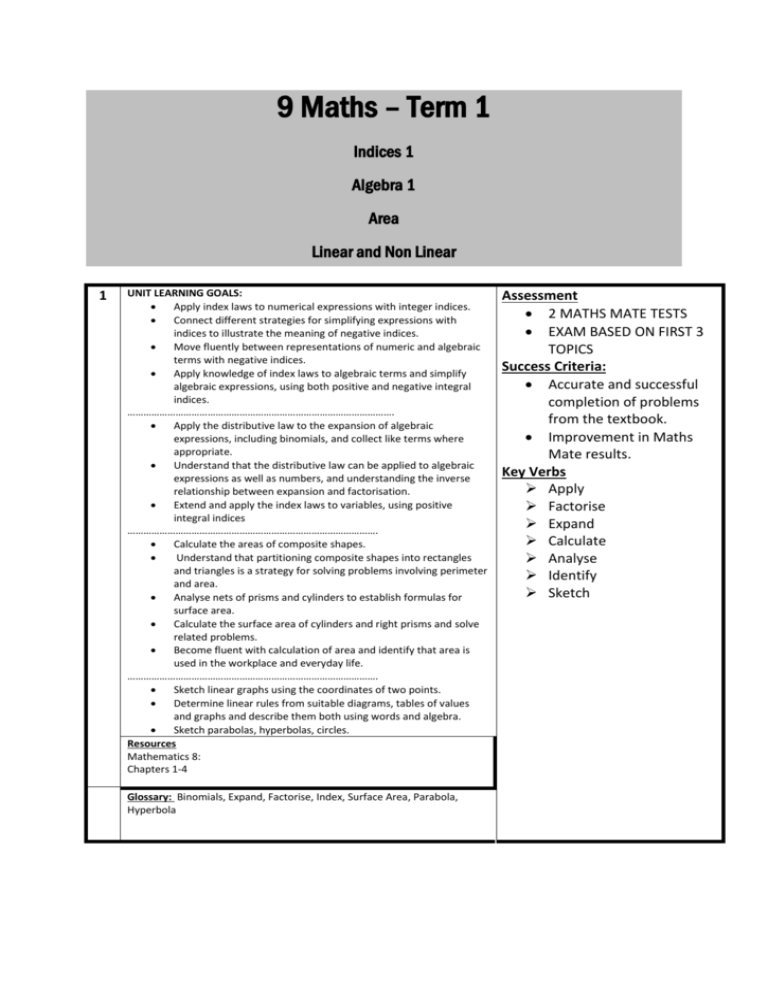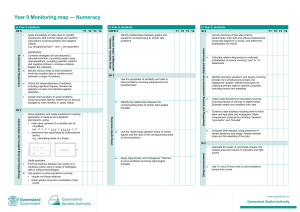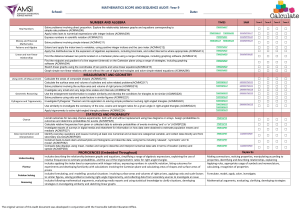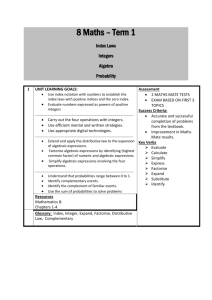Year 9 Unit Plan
advertisement

9 Maths – Term 1 Indices 1 Algebra 1 Area Linear and Non Linear 1 UNIT LEARNING GOALS: Apply index laws to numerical expressions with integer indices. Connect different strategies for simplifying expressions with indices to illustrate the meaning of negative indices. Move fluently between representations of numeric and algebraic terms with negative indices. Apply knowledge of index laws to algebraic terms and simplify algebraic expressions, using both positive and negative integral indices. ………………………………………………………………………………………. Apply the distributive law to the expansion of algebraic expressions, including binomials, and collect like terms where appropriate. Understand that the distributive law can be applied to algebraic expressions as well as numbers, and understanding the inverse relationship between expansion and factorisation. Extend and apply the index laws to variables, using positive integral indices …………………………………………………………………………………. Calculate the areas of composite shapes. Understand that partitioning composite shapes into rectangles and triangles is a strategy for solving problems involving perimeter and area. Analyse nets of prisms and cylinders to establish formulas for surface area. Calculate the surface area of cylinders and right prisms and solve related problems. Become fluent with calculation of area and identify that area is used in the workplace and everyday life. …………………………………………………………………………………. Sketch linear graphs using the coordinates of two points. Determine linear rules from suitable diagrams, tables of values and graphs and describe them both using words and algebra. Sketch parabolas, hyperbolas, circles. Resources Mathematics 8: Chapters 1-4 Glossary: Binomials, Expand, Factorise, Index, Surface Area, Parabola, Hyperbola Assessment 2 MATHS MATE TESTS EXAM BASED ON FIRST 3 TOPICS Success Criteria: Accurate and successful completion of problems from the textbook. Improvement in Maths Mate results. Key Verbs Apply Factorise Expand Calculate Analyse Identify Sketch 9 Maths – Term 2 Proportion Pythagoras’ Theorem Statistics Geometry 1 UNIT LEARNING GOALS: Solve problems involving direct proportion. Explore the relationship between graphs and equations corresponding to simple rate problems. Understand the difference between direct and inverse proportion, identifying these in real-life contexts and using these relationships to solve problems. ………………………………………………………………………………………………………………… Investigate Pythagoras’ Theorem and its application to solving simple problems involving right-angled triangles. Understand that Pythagoras’ Theorem is a useful tool in determining unknown lengths in right-angled triangles and has widespread applications. Recognise that right-angled triangle calculations may generate results that can be integral, fractional or irrational numbers known as surds. …………………………………………………………………………………………………………………. Identify everyday questions and issues involving at least one numerical and at least one categorical variable, and collect data directly from secondary sources. Construct back-to-back stem-and-leaf plots and histograms and describe data, using terms including ‘skewed’, ‘symmetric’ and ‘bi modal’. Compare data displays using mean, median and range to describe and interpret numerical data sets in terms of location (centre) and spread. ……………………………………………………………………………………………………………… Use the enlargement transformation to explain similarity and develop the conditions for triangles to be similar. Solve problems using ratio and scale factors in similar figures. Resources Mathematics 8: Chapters 6-9 Glossary: Direct Proportion, Surd, Irrational, Categorical, Stem and Leaf, Skewed, Bi Modal, Histogram, Transformation Assessment 2 MATHS MATE TESTS EXAM BASED ON FIRST 3 TOPICS Success Criteria: Accurate and successful completion of problems from the textbook. Improvement in Maths Mate results. Key Verbs Solve Investigate Compare Construct 9 Maths – Term 3 Indices II Trigonometry I Volume Probability 1 UNIT LEARNING GOALS: Express numbers in scientific notation. Understand that the use of index notation is an efficient way of representing numbers and symbols and has many applications, particularly in science. Represent extremely large and small numbers in scientific notation, and numbers expressed in scientific notation as whole numbers or decimals. Apply index laws to numerical expressions with integer indices. Apply knowledge of index laws to algebraic terms and simplify algebraic expressions, using both positive and negative integral indices. Measurement and Geometry → Units of Measurement Investigate very small and very large time scales and intervals. Investigate the usefulness of scientific notation in representing very large and very small numbers. ………………………………………………………………………………………………………………… Use similarity to investigate the constancy of the sine, cosine and tangent ratios for a given angle in right-angled triangles. Develop an understanding of the relationship between the corresponding sides of similar right-angled triangles. Apply trigonometry to solve right-angled triangle problems. Understand the terms ‘adjacent’ and ‘opposite’ sides in a right-angled triangle. …………………………………………………………………………………………………………………. Calculate the volume of cylinders and solve related problems. Solve problems involving the volume of right prisms. Build on the understanding of volume to become fluent with calculation, and identify that volume relationships are used in the workplace and everyday life. ……………………………………………………………………………………………………………… . List all outcomes for two-step chance experiments, both with and without replacement using tree diagrams or arrays. Assign probabilities to outcomes and determine probabilities for events. Calculate relative frequencies from given or collected data to estimate probabilities of events involving ‘and’ or ‘or’. Posing ‘and’, ‘or’, ‘not’ and ‘given’ probability questions about objects or people. Collect data to answer the questions using Venn diagrams or two-way tables. Resources Mathematics 8: Chapters 11-14 Glossary: Scientific notation, Adjacent, Opposite, Hypotenuse Assessment 2 MATHS MATE TESTS EXAM BASED ON FIRST 3 TOPICS Success Criteria: Accurate and successful completion of problems from the textbook. Improvement in Maths Mate results. Key Verbs Apply Investigate Simplify Calculate Pose 9 Maths – Term 4 Data Trigonometry II Algebra II Coordinate Geometry 1 UNIT LEARNING GOALS: Investigate techniques for collecting data, including census, sampling and observation. Investigate reports of surveys in digital media and elsewhere for information on how data were obtained to estimate population means and medians. ………………………………………………………………………………………………………………… Apply trigonometry to solve right-angled triangle problems. Understand the terms ‘adjacent’ and ‘opposite’ sides in a rightangled triangle. Select and accurately use the correct trigonometric ratio to find unknown sides and angles in right-angled triangles. …………………………………………………………………………………………………………………. Apply the distributive law to the expansion of algebraic expressions, including binomials, and collect like terms where appropriate. Understand that the distributive law can be applied to algebraic expressions as well as numbers, and understand the inverse relationship between expansion and factorisation. Extend and apply the index laws to variables, using positive integral indices. ……………………………………………………………………………………………………………… .Find the distance between two points located on a Cartesian plane using a range of strategies, including graphing software. Investigate graphical and algebraic techniques for finding distance. Find the midpoint and gradient of a line segment (interval) on the Cartesian plane using a range of strategies. Investigate graphical and algebraic techniques for finding midpoint and gradient. Resources Mathematics 8: Chapters 16-19 Glossary: Census, Sample, Survey, Distributive Law, Midpoint, Cartesian Plane, Gradient Assessment 2 MATHS MATE TESTS EXAM BASED ON FIRST 3 TOPICS Success Criteria: Accurate and successful completion of problems from the textbook. Improvement in Maths Mate results. Key Verbs Investigate Select Solve Apply Factorise Expand





